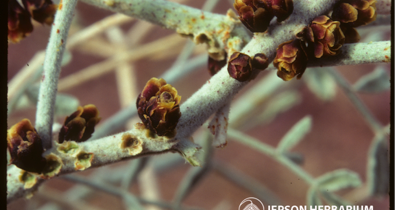There is a little plant hiding out in the southwestern United States known by the name of Thurber’s Stemsucker (Pilostyles thurberi). It’s difficult to spot because it lives entirely within the stems of shrubs in the legume family, with no true stem, leaves, or roots of its own. It can only be seen once it flowers, typically in January, as the buds burst through the stems of the host plant in order to allow pollination and seed dispersal. The plants are dioecious, and are thought to rely on small bees, wasps, or ants for pollination. Although fairly unique in its specific method of growth, Pilostyles is just one of many genera which act as parasites. A recent study of several parasitic plants’ and their hosts’ mitochondrial genes found that in addition to taking nutrients from the host plant, these parasites have historically participated in horizontal gene transfers. This is evident in the atp1 gene, which is more similar between hosts and their parasites than among the parasitic plants. The authors also find a specific sequence within the coxI gene to be very strongly correlated with origins of parasitism.
--Erin Patterson
(Image by James T. Vale, from UC Jepson Herbaria Image Collection)
